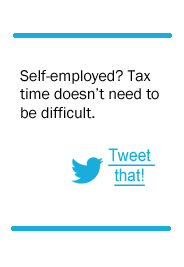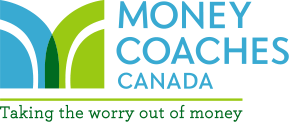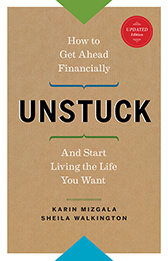By Karin Mizgala, Co-Founder and CEO Money Coaches Canada
 When people choose self-employment, they are often attracted to the challenge and excitement of creating a business they are passionate about. They may look forward to a more flexible work schedule, or the possibility of earning more than they did as an employee. The one thing most people don’t get excited about is keeping track of all their expenses and planning for their income taxes.
When people choose self-employment, they are often attracted to the challenge and excitement of creating a business they are passionate about. They may look forward to a more flexible work schedule, or the possibility of earning more than they did as an employee. The one thing most people don’t get excited about is keeping track of all their expenses and planning for their income taxes.
If you are self-employed, you need to be aware of a looming tax deadline. Sole proprietors have until June 15th to file (as do their spouses), but their balance owing is due as of April 30th. If you aren’t paid up by then, interest will be charged until you are.
When your numbers are in order, then reach out to the CRA with a proposed plan to pay off your balance owing. Keep in mind that you’ll also need to save the money for the taxes you are incurring on your new income.
Procrastination in handling the financial side of your business can result in frustration, or even panic, as the tax deadline looms. To help, I’ve outlined a few suggestions on what to do if you find yourself unprepared to file this year’s return, and what you can do differently going forward.
But first, let’s look at some of the challenges and pitfalls you may encounter as a small business owner.
There are some real tax challenges for the self-employed. For example, your income will likely vary from month-to-month, making it difficult to estimate annual earnings and thus the appropriate tax rate. A varied income also makes it hard to create a cash-flow plan. And even if you create a plan, it can be difficult to honour when cash flow is tight.
Then there are the pitfalls of inexperience. Losing track of receipts, mixing personal expenses with business expenses are just some of what our Money Coaches regularly see with self-employed clients. Many have no clear sense of how much to set aside for income taxes and are missing filing deadlines and incurring penalties. Even though most entrepreneurs are incredibly busy, many make their professional lives even more challenging by not using a bookkeeper or professional accountant to help with their tax preparation/filing. Sound familiar?
What do you do if you find yourself unprepared for this year’s return? Here are a few suggestions:
 Take a deep breath.
Take a deep breath.- Set aside time to find and organize as many receipts as you can.
- If you don’t have a system of keeping receipts, now is a great time to create one so you will be well organized for next year’s taxes. It can be as simple as keeping all business expense receipts in envelopes, one for each month of the year, or as fancy as a phone app to take a picture of each receipt, categorize them and upload a report to your bookkeeping software.
- You can use your business bank records and credit card statements to confirm you haven’t missed any big expenses, but remember that the CRA will need the original purchase receipt, a credit card slip alone will not be sufficient in an audit.
- Remember to include “business use of home” expenses, such as a portion of your rent/mortgage, utilities, home insurance, and cleaning supplies..
- If you made any large purchases of equipment or furniture, these need to be identified as capital costs, so separate them into their own category.
- If you use your car for business, you will need to determine how many kilometres you drove in total for the year, and how many of those were for business use – then the same ratio of the expenses related to the car can be used as business expenses.
If all that seems overwhelming, understand that the biggest step is creating the system – it gets much easier once the system is in place. And at some point you may want to consider getting help from an accountant, bookkeeper or money coach.
If it turns out that you owe more than you can afford to pay, make sure you file anyway to avoid late filing fees. Then contact a tax services office to arrange a mutually acceptable payment plan.
What can you do differently going forward?
Not making the same mistake twice is an important life lesson, and one that applies equally well in business. Here are six recommendations, designed specifically for the self employed, to proactively deal with income taxes:
- Forecast your estimated income and expenses for the year. It can be a challenge but look at your earnings and expenses from last year and try to extrapolate going forward.
- Estimate your taxes owing: Once you know your net income (revenue – expenses) you can consult a tax professional, Money Coach, or use an online calculator to determine your estimated taxes owing.
- Set up a plan to save monthly towards your taxes. Either a set amount or a % of your revenues will work – as long as you follow through. The CRA may require you to pay your taxes on a quarterly basis going forward, so it is vital that you have that money set aside so you can avoid late payment interest charges.
- Be clear on your personal cash flow needs – figure out how much you need each month for business expenses, but also be conscious of how much you can afford to pay yourself from your business income.
- Pay yourself a regular amount from your business account to your personal account. This will help even out the financial ups-and-downs of being self-employed.
- Set-up a system to stay on top of your receipts, bookkeeping, tax payments, and payments to yourself.
Avoiding the financial side of your business, at best, creates an energy drain, or at worst can place your self-employment dream in jeopardy.
Once you have a plan and systems in place, you can reinvest that energy into the parts of your business that make you excited to get to work each morning.



The biggest challenge that I have found is to keep track of expenses when traveling. The extra expenses related to overnight accommodation, parking, meals, and dry cleaning for me are not part of my normal expense-tracking routine. The use of cash for some expenses adds to the challenge of remembering “where did my money go?”
Bruce, have you considered a separate credit card just for work / traveling expenses? It might help with tracking of these expenses.
I’m a self employed painter and I’m confused as to if I need to take my deductions before or after business expenses ie…
Job = $3000 total. I pay $600 in materials , $300 in fuel, another $250 in expenses which leaves me with $1850. Now do I take my tax, cop, rain deductions from the $3000 Or from the $1850
Great question! The CPP and income taxes you owe are calculated on your NET income (after expenses) – the $1850 in your example. The CPP is 9.9% of your earnings (to a maximum of $5128.20 in 2017) and the income tax rate changes depending on your tax bracket which is determined by your full annual income.
There are a few strategies that can work to get these funds set aside and it often depends on the nature and complexity of your business.
To keep things simple I often recommend that you don’t try to do the math on each job. This requires you to be up to date on your bookkeeping and if not then you may end up spending the funds before you get a chance to set them aside.
Instead you can look at your total amount for the job or your total of the month and set aside a % of the GROSS amount of cash you received – eg 20%, 25% or 30% into a separate savings account labelled “Taxes” . This ensures you have the money set aside and if you have over saved at tax time that’s good news, if you owe a bit more then you can increase your % that you save going forward.
Consider working with a financial professional such as Money Coach to help you set up a clear supportive cash flow system to support your business and your life.
I have just recently filed my tax return for 2017, my gross income was 30000 dollars as I was only self employed for six months, I have received a figure of 5000 dollars tax to pay, does this amount include my deductions or will I receive a rebate from cra after I pay?
Hi Brian,
I can’t comment on your specific tax situation without having seen your return. In creating self employed income you will be responsible to cover federal taxes, provincial taxes and Canada Pension Plan contributions. There is a basic federal personal exemption of $11,635 (and also a provincial personal income exemption defined by your province). This means that this amount of earnings are tax free and any money earned above that is taxed as per provincial and federal tax brackets. When you prepare your taxes the basic personal amounts are deducted from your gross income before the tax calculation is done. If you have other deductions to claim this would also be accomplished on your tax forms. If you are unsure how to complete the forms accurately you may consult a tax professional. If the taxes owing feels like a hardship you may also benefit from doing some planning regarding your income and tax liabilities at the beginning of the year so you understand how much to set aside for income tax. If your income goes up in 2018 you will also need to consider when to apply for a GST # if you don’t already have one. This will also require some planning on how to ensure you are covering that liability so you don’t end up with a surprising tax bill. You may find real value and peace of mind working with a Money Coach to assist you to plan and ensure tax time is smooth and stress free. All the best to you!
I started my business as a sole proprietor in April 2017 and when I met the accountant at that time, he told me that if I was under 30 000$ of income during the year, I would not have to apply for a GST#. However, after looking at the numbers at the end of the year, and not really paying attention during the last months, I noticed that I was close to 55 000$. What should I do in that case? Should I call the CRA and see what my options are in terms of tax filing, etc.? Thanks! David
Hi David!
Congratulations on generating more income than you expected! I work with many clients who find their businesses growing faster than expected and it is important to keep good financial records and be setting aside tax liabilities. Good planning is priceless and having a money coach, bookkeeper and accountant on your team can save you time and money.
The government does not require you to register if you are considered a “small supplier”. Once you have generated over $30,000 in sales in any one quarter OR within the last four quarters you are no longer considered a small supplier and you need to register for a GST#. A calendar quarter means a period of three months beginning on the first day of January, April, July, or October in each calendar year. You start charging the GST/HST at the beginning of the month after you cease to be a small supplier. You are required to register within 29 days of the time you cease to be small supplier.
When you needed to register and collect GST depends on when you exceeded the threshold so keeping good monthly financial records is important. Check out this CRA link for more information and examples of scenarios of when to register. Contacting them to be sure you understand your tax liability is a good idea and if you owe GST consider setting up you cash flow system in a way that ensures you always have the money when the tax is due. Please be in touch directly if you want the support of a coach!
Cheers,
Melanie
Link to CRA
https://www.canada.ca/en/revenue-agency/services/tax/businesses/topics/gst-hst-businesses/charge-gst/charge-gst-hst.html#apply
HI Bruce
Thanks a lot for posting all these information. Really enjoyed your blog!
I am working as a Secretary in a Realty Brokerage in Toronto and file tax by T4A.
I know I need to register a HST# when I meets $30000 annual income.
For the 13% I need to pay to CRA, does it counts from the 1st dollar I earn after I registered the HST# ?
Someone told me that wages doesn’t need to pay the 13% tax to CRA.
I’m so confused. Please advise, thank you so much !
Hi Yip;
Because you have a T4A slip which I assume is commissions versus wages (T4slip) I suggest you contact the GST general inquiries department at 1-800-959-5525 to see first if this type revenue is GST taxable.
Thank you.
I haven’t yet reached the 30,000 so no GST. I’ve been setting aside 25% of my income right off the top for taxes. Is this too much or too little? It’s seems like such an enormous chunk of my income :(
Hi Brandice,
GST and Income taxes are two very separate taxes. 25% could be too high for income tax alone. You could try using a tax calculator like Simple tax to estimate your taxes owing and also your CPP. As you are self-employed you pay both sides of the CPP equation, meaning you would pay 9.9% of your income to CPP. As an employee we pay 4.95% and as self-employed you pay both the employee and employer side of the equation (though the employer part is an expense for you when calculating your net income).
Your income tax calculation “depends” somewhat on your expenses that you need to pay to earn the income. Your net income (gross sales less your tax deductions) determines your average tax rate at the end of the year. From there you can calculate your tax owing at the end of the year.
There could be other benefits to registering for GST before hitting $30,000. You could “look like” you make more than $30,000 when you are sending invoices, and not everyone will know you make under $30,000.
The bottom line is to start off with estimate your income and expenses to get your numbers and projections on track from the start. Working with a Money Coach would help create you create a cash flow projection for your personal and business expenses and give you the tools you need to start off on the right track and feel confident about your numbers.
Hello,
How about providing a services rather than sales? Do I need to apply for a GST#? Thanks.
Hi Kathy, Thank you for your question!
Sales refers to both goods and services, so the same rules apply if you are a service provider.
Most supplies (including services) are subject to GST; however, some things are zero-rated or are exempt from GST. In these cases, you don’t charge your customers GST for them.
Without knowing the details of your business, I can’t comment specifically for you, but you can find some information about this on the CRA website (see the link below). You should contact a tax professional and CRA to help you determine whether you need to register and start collecting GST, based on your revenues and the services you sell. If so, as a registrant you may be able to claim input tax credits (ITCs) to recover the GST you pay when purchasing supplies for your own business.
In any case, a Money Coach can help you set up a system to ensure you are staying on top of your personal and business cash flows, keeping track of the amounts you need to set aside for GST and/or other taxes, and remitting to CRA on time.
CRA webpage for information about GST/HST:
https://www.canada.ca/en/revenue-agency/services/forms-publications/publications/rc4022/general-information-gst-hst-registrants.html
If you are making under 30,000 a year and are self employed not charging tax to customers can you still write stuff off
Yes, you can still write off expenses against your self-employed income.
In one of my case study, it talks about self employed person who took help of her Friends in her business.she recorded their hours but in reality they were doing free of cost. She did so because she want to claim deductions.
so can a self employed person take such deductions?
If the friend didn’t compensate the person who worked for her, she should not claim a deduction. If there are other extenuating circumstances not outlined in your comment, please consult your accountant.